9 mins
A MARATHON NOT A SPRINT
From state-of-the-art laser scanning and drone-based mapping to advanced geospatial data analytics, CATRIN JONES looks at surveying’s development
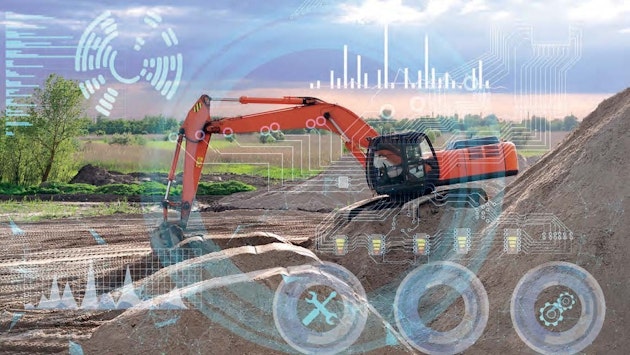
A RELUCTANCE TO ADOPT TECHNOLOGY IS PREVENTING SOME
COMPANIES FROM REAPING THE BENEFITS
OF AUTOMATION
PHOTO: ADOBESTOCK
Contractors are facing increasing pressure to complete projects within shrinking budgets and timelines. Additionally, the need for sustainable practices, a shortage of skilled labour and the rising costs of fuel and materials have made the situation even more challenging for the construction industry.
However, a technological advance that has the potential to help tackle these problems is machine control. By accurately positioning machinery on construction sites and automating their movements based on approved design layouts, machine control can help teams complete projects faster and more accurately – and with less fuel consumption, and fewer skilled personnel.
Last year, Topcon conducted research into the future of machine control. In the report, the global positioning company highlighted the rate of adoption, as well as factors that are slowing it down.
The company’s research shows that contractors are no strangers to machine control, with all but 3% of respondents claiming to use automation in some capacity. Despite this, Topcon’s report states that 46% are using it on less than a quarter of their projects, suggesting that, for many, their experience with machine control is still in its infancy or confined to limited types of projects or applications.
The report, surveyed across Europe, suggests that Germany (36%) and Scandinavia (36%) are the biggest adopters of automation. This is closely followed by the UK at 32% and Belgium at 31%.
It appears that the construction industry is using machine control, but only on 34% of projects on average, indicating that automation is not yet fully embraced.
John Downey, senior director of sales at Topcon Positioning Systems, says, “Investigation into the barriers to adoption reveals a working environment where machine control struggles to compete against a range of other, arguably more immediate, concerns for the time and investment needed to implement the technology on more projects.
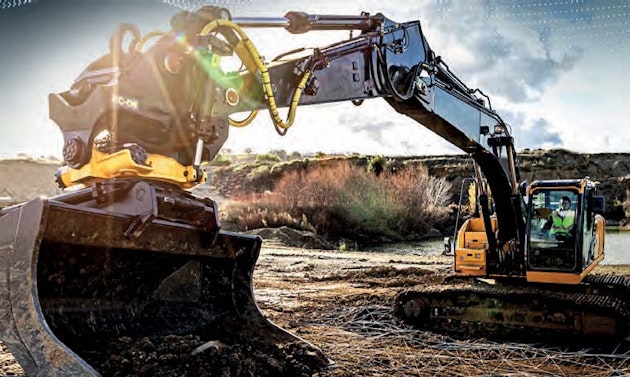
TOPCON HAS CONDUCTED COMPREHENSIVE RESEARCH INTO THE FUTURE OF MACHINE CONTROL
PHOTO: TOPCON
“It is in this context that the need for more government support and regulatory pressure is imperative, which will add urgency and incentive to embrace digital construction methods.”
It is clear that these barriers to adoption are preventing some companies from reaping the benefits of automation, but what is the real potential for automation and how can it change traditional construction processes? Cameron Clark, business area director for earthmoving at Trimble, says that automation is transforming traditional construction processes in two key ways – by making it easier to get the job done faster, with greater accuracy and fewer people, and by making it easier to gather and share jobsite data for better decision-making.
Clark says, “Task automation is helping contractors of all sizes offset the challenges of the labour shortage because it allows them to do the same work with fewer or less experienced people.
MACHINE
“In some cases, automating tasks on the job site means you can now do with one person what used to take two – which is instrumental in keeping jobs moving when there just aren’t enough people to do the work.” Automation is also making these jobs more appealing for workers, which helps offset hiring challenges adds Clark.
"AUTOMATING TASKS ON THE JOB SITE MEANS YOU CAN NOW DO WITH ONE PERSON WHAT USED TO TAKE TWO"
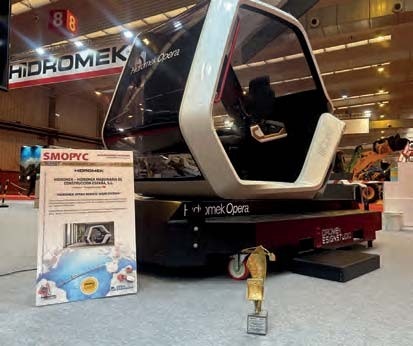
PHOTO: HIDROMEK
“Horizontal steering control makes the job of operating a soil compactor much easier and more enjoyable, for example, which makes it easier to find people who are interested in doing it and helps improve job satisfaction among operators.”
Trimble says that it is about more than just automating one machine or one task, but about connecting machines, people and the field to the office.
“This is transforming job sites in a lot of compelling ways, including reducing trips between the office and field, making it easier to share and make decisions from real-time job site data, and eliminating wasted time, materials and money,” the company says.
TIME FOR A FULL TRANSITION
Ferhan Ficici, engineering manager for backhoe loaders and wheeled loaders at Hidromek, agrees with Clark that the trend toward automation does have an impact on the traditional construction process. He believes, however, that the industry is making positive moves towards a full transition.
During the last couple of years, the operational process has changed in all sectors, and it is still changing. Despite this change, safety is still paramount and something that many companies are seeking to improve.
Ficici says, “With advancements in sensors, actuators, embedded software, AI and cloud computing, operator assist systems are being developed. This makes working fields and machines safer. Added to this, the developments in radar and camera technologies are providing a great contribution to occupational safety.”
Naturally, this transition has affected the construction machinery industry. Ficici continues, “Construction machines have a very wide working field range, including difficult or dangerous sites such as tunnel constructions or sites where blasting occurs. “Heavy machinery operators are often exposed to harsh and dangerous environments around the job site. Remote controlling solves such troubles and creates an optimal work environment for operators.”
METSO’S REMOTE IC FOR LOKOTRACK CRUSHERS AND SCREENS
Metso has launched a new software application, Metso Remote IC, which has expanded its smart crushing and screening solutions. The new Metso Remote IC is used for remote control and monitoring of the crushing and screening process, and it connects wirelessly all the Lokotrack crushers and screens at the site.
With the Metso Remote IC app, the operator can view all the Lokotrack train machines and their main process parameters using a single dashboard.
The feeder and crusher settings can be adjusted from the excavator cabin, and the overall visibility of the process allows the operator to adjust the feeding for an optimal production level.
In problem situations, the Remote IC automatically stops the feeder, thus preventing overloading. It also instantly alerts and provides a reason for the stoppage, making it quicker and easier to get back to operation. With a lower overflow risk, the process can be run closer to maximum capacity.
The Remote IC app can be operated by one person and viewed by many. Everyone at the site can view the main process parameters and alarms. For example, the wheeled loader driver can acknowledge the alarm and fix the problem.
The Metso Remote IC app can be used on Android tablet or mobile phone.
It is available for all new Lokotrack models and can also be installed as a retrofit to all models that have the latest Metso Metrics installed.
Metso Metrics is a cloud-based service for real-time performance information, maintenance planning and fleet management that works as a remote monitoring tool off-site.
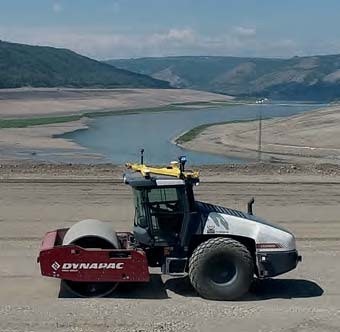
THE TRIMBLE EARTHWORKS GRADE CONTROL PLATFORM FOR AUTONOMOUS COMPACTORS WAS INSTALLED ON A DYNAPAC CA 5000 SOIL COMPACTOR
PHOTO: TRIMBLE
Hidromek says it is running studies on how best to contribute to digitalisation and the company launched Hidromek Opera as a result of this research.
Opera enables the operator to control the requested machines from the office or any other place without going to the job site. The company recently exhibited Hidromek Opera at the Smopyc trade fair in Spain, from where it remotely operated an HMK 635 WL wheeled loader located in Ankara, Turkey.
WHAT IS THE FUTURE OF MACHINE CONTROL?
Trimble’s Clark anticipates that automation will continue its slow but steady march forward over the next decade and into the future, with a focus on automating new tasks on new machine types.
“We are actively testing a fully autonomous soil compactor on live job sites and would expect to see more of this kind of testing and innovation in coming years, as well,” he says. During Trimble’s Dimensions conference in Las Vegas, US, last year, the industry heard about how the company has completed its first test of a fully autonomous soil compactor on a live job site, marking a significant step on its path to having autonomous vehicles operating on construction sites.
The Trimble Earthworks Grade Control platform for autonomous compactors was installed on a Dynapac CA 5000 soil compactor and was tested on the Site C Clean Energy Project at the Peace River in northeast British Columbia in Canada.
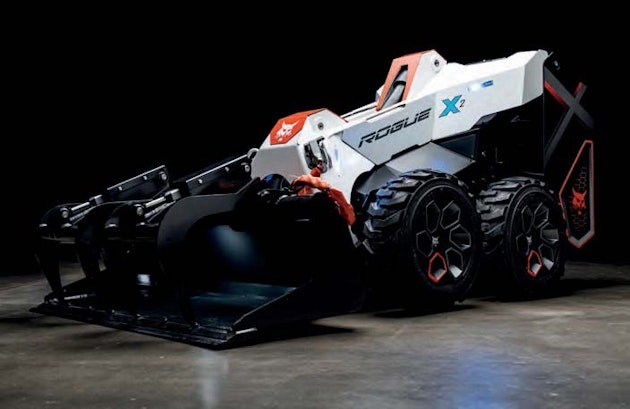
BOBCAT’S ROGUE X2
SKID STEER LOADER
PHOTO: BOBCAT
JCB AND LEICA TEAM UP ON EXCAVATOR CONTROL SOLUTIONS
JCB and Leica Geosystems, part of Hexagon, have announced that they are joining forces to offer factory-fitted 2D and 3D-ready semiautomated excavator control solutions.
From March 2024, the solutions - known as Intelligrade - will be available initially on the JCB 220X tracked excavator in the UK before being offered across the whole JCB X Series range in additional regions.
Leica Geosystems 2D and 3D-ready machine control solutions are available with semi-auto configuration to enhance productivity, accuracy, and safety by automating functions such as boom, bucket and tilt rotator control, and to reduce human error in construction operations.
Working to predetermined site plans, the 2D machine control system is said to provide real-time guidance and accuracy for tasks such as grading and levelling, ensuring the excavator’s bucket or blade achieves the desired slope or elevation. This solution is ideal for projects that involve simple terrain or require basic grading. Users can also choose the 3D-ready option to retain the flexibility of upgrading to 3D in the future.
“We are committed to innovation with our X Series range and this introduction will mean new levels of efficiency and reduced operating costs. In addition, it gives operators greater levels of accuracy when using X Series machines, delivering high standards on construction sites. It also reduces the need for additional surveyors on site, leading to enhanced levels of safety,” said Paul Swallow, business head of excavators, JCB.
“Leica Geosystems is a leader in the field of 2D and 3D machine control and, by integrating these products at the factory, it ensures they are perfectly set up and available to use from the outset. Customers can achieve all the benefits of semi-auto machine control without the disruption or complexity of retrofitting in the field.”
“We like to remind our customers that the industry’s innovation around and adoption of construction automation is a marathon, not a sprint,” highlights Clark.
“But there are real solutions on the market right now that are delivering big benefits on job sites in terms of being able to do more work, with increased accuracy and safety.
Another big benefit of the technology available today is the ability to get less experienced workers up to speed faster, so you can get the same work done with fewer – or newer – people.”
Artificial intelligence (AI) is already revolutionising the construction industry and we are not far away from this flowing into our machines, says Vijayshekhar Nerva, head of innovation and acceleration for Europe, Middle-East and Africa at Bobcat.
“AI and machine learning are already enabling predictive maintenance to minimise downtime in many cases however I see a future where such technology could allow for complex autonomous operations, enhance awareness through AI-powered hazard detection, and optimise design and planning processes,” Nerva comments.
“This transformation could bring significant benefits like increased productivity, improved awareness, cost savings, and higher quality construction work.”
However, Nerva cautions, challenges such as the upfront costs of implementation, the need for workforce upskilling, cybersecurity risks and gaining trust in autonomous systems will need to be addressed.
Despite the current challenges it is highly likely that the future of the industry will be shaped, in no small part, by this technology. CT